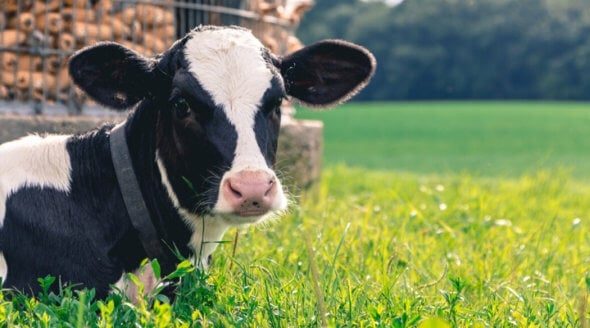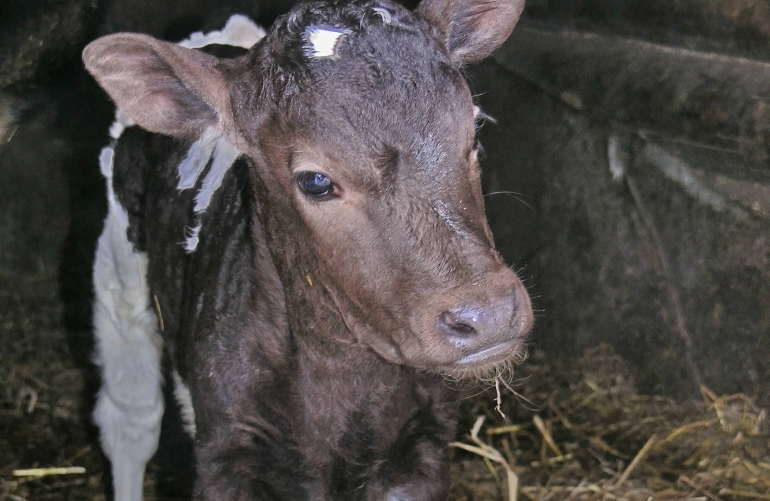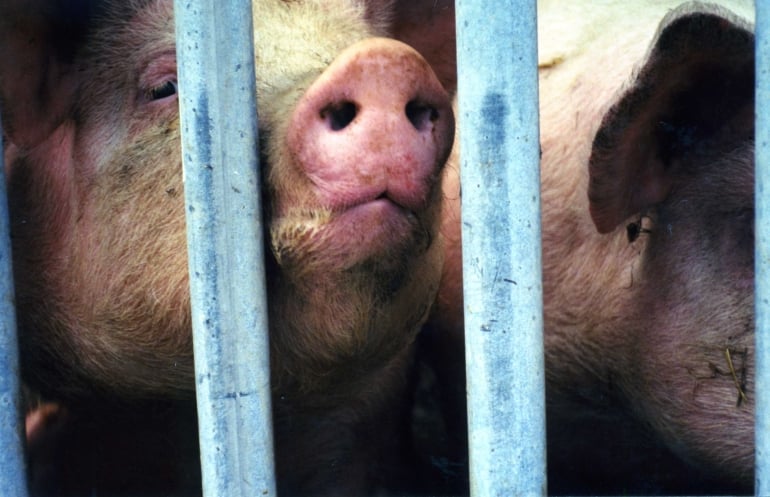Animals Killed for Meat
The meat industry is by far the biggest killer of animals around the world. It’s also responsible for relentless, routine cruelty to pigs, sheep, cows, chickens, ducks, geese, and other animals on farms, who suffer for every minute of their short lives.
The story is similar for all animals reared for their flesh. Females are repeatedly forcibly impregnated. Babies are torn away from their mothers, mutilated, and kept in filthy and severely crowded conditions. Then, often when they’re only a few months old, they endure a stressful and terrifying trip to the abattoir, where many are ineffectively stunned and therefore killed while still conscious.
Chickens | Cows | Ducks and Geese | Pigs | Sheep
Chickens
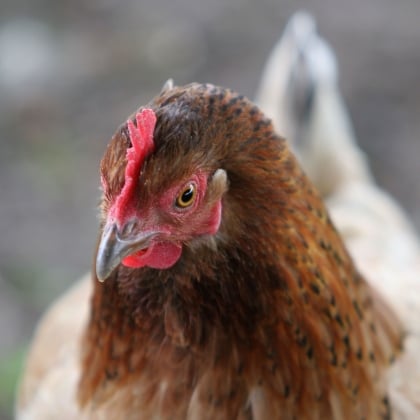
Chickens on grim factory farms commonly suffer from severe health problems, including deformed or arthritic legs because of excess weight gain, foot rot from never having their bedding changed, infectious diseases caused by pathogens such as salmonella and listeria, and heat stress, heart failure, breast blisters, and dermatitis as a result of severe crowding. As if this weren’t bad enough, farmers frequently subject the animals to agonising procedures such as amputating part of their beaks with an infra-red laser.
The birds are sent to slaughter without ever having roosted in a tree, taken a dust bath, interacted with their parents, or done any of the other things that are important to chickens. They’re roughly shoved into crates and driven to the abattoir, where they’re stunned before slaughter either by gassing or by being shackled by the legs and hung upside down on a production line so that their heads can be plunged into an electric water bath. The stunning doesn’t always work, so they sometimes regain consciousness as their throats are being cut, as they bleed to death, or as they’re plunged into defeathering tanks filled with scalding-hot water.
Cows
Cows used for beef can be kept on intensive factory farms and may spend their entire lives indoors, never grazing in the open air or having space to move around. They’re “fattened up” on a highly unnatural cereal-based diet that causes them almost-constant digestive pain and can lead to metabolic diseases. Some hellish, artificially lit sheds have slatted floors, which are uncomfortable for cows to lie on. Even grass-fed cows usually spend some of their time inside, often in crowded, faeces-filled feedlots. And many animals develop respiratory problems because of the choking chemicals that fill the air caused by the piles of manure in the packed sheds.
During the journey to the abattoir, cows frequently collapse from exhaustion. Once unloaded, they’re shot in the head with an electric bolt gun in order to stun them. But inept, overworked workers often fail to do this properly, so many terrified cows go to their deaths kicking and screaming, still conscious as they’re skinned and dismembered.
There are many stories of cows making extraordinary dashes for freedom on their way to the abattoir by jumping from moving lorries, leaping fences, and swimming across rivers – because animals value their lives just as we do ours.
For veal, male baby calves born to mothers in the dairy industry are shipped to the continent when they’re only a few days old. There, they’re confined all alone to dark crates, with no room to move. Cows are inquisitive, social animals who form close bonds with each other, so being kept in isolation is torment for them. The frightened animals may be fed a diet that’s purposely low in iron so that they become anaemic, their muscles atrophy, and their flesh remains pale. By the time they’re sent to be killed, many of these infants are so weak that they can barely walk up the ramp to the abattoir.
Ducks and Geese
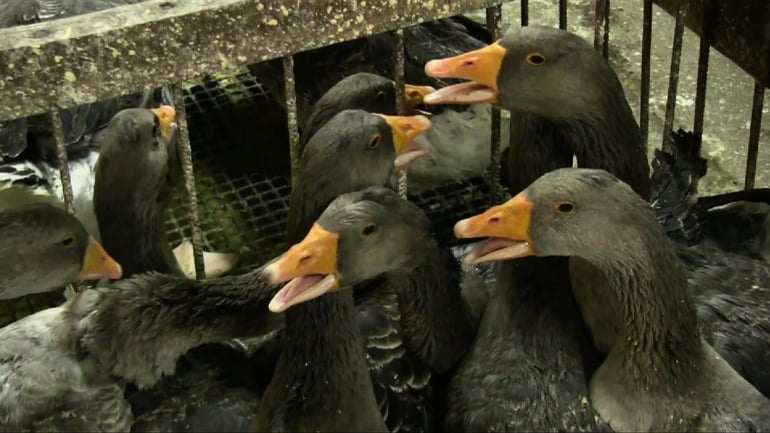
Some birds endure a still more horrific ordeal: being force-fed for the production of foie gras, a notoriously vile foodstuff that’s illegal to produce in the UK but can still be imported and sold here. To make the “fatty liver” pâté, workers grab ducks and geese by the neck, shove long metal pipes down their throats, and pump massive amounts of grain directly into their stomachs several times a day in a barbaric process known as gavage.
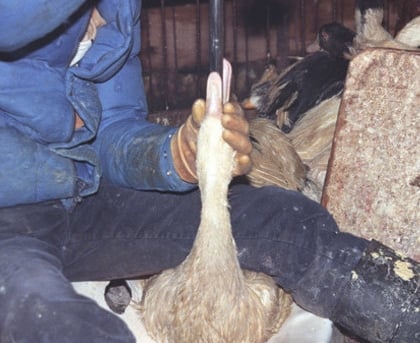
Veterinarians agree that there’s no humane way to produce foie gras. PETA has undercover video footage of foie gras farms in France that clearly shows that force-feeding causes birds intense, prolonged suffering. Awareness of the cruelty of foie gras production is growing, and increasing numbers of chefs and retailers now refuse to sell the product. PETA will keep campaigning against this “delicacy of despair” until it’s banished from British shelves, and you can help – here’s what to do if you see foie gras on the menu.
Pigs
Pigs are friendly, loyal, and intelligent animals who often outperform dogs in learning tests. They are naturally very clean, live in small family groups, and love playing, exploring their surroundings, foraging for food, and building nests for their offspring.
But pigs imprisoned on factory farms don’t have the chance to engage in this natural behaviour. Crammed into barren concrete pens, they may never see the sun or breathe fresh air. The frustration and stress of extreme confinement with nothing to stimulate their sharp minds can drive them to engage in aggressive behaviour such as ear- and tail-biting, so farmers routinely cut off their tails and grind down their sensitive teeth, usually without painkillers. Male piglets may be castrated without anaesthetics – a barbaric procedure that’s legal in the UK – to prevent “boar taint”, whereby the pheromones of intact males give their flesh a bad taste.
For a couple of weeks before and after they give birth, mother pigs are confined to farrowing crates so small that they can’t even turn around, let alone fulfil their strong urge to build a nest as they would naturally. They’re artificially inseminated over and over again – the piglets in each litter are separated from them by bars in the crate and are then torn away from them after only a few weeks, transferred to fattening pens, and ultimately sent to the abattoir. There, the cruelty continues – the animals are hoisted upside down by their back legs and their throats are cut, often without effective stunning. About 10 million pigs meet this fate each year in the UK alone.
Sheep
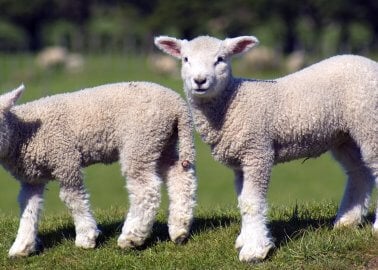
Sheep left out on the hillsides hardly fare better. They’re often shamefully neglected, suffering from lameness, painful infections, flystrike, and parasites such as ticks. And every winter, thousands of animals freeze to death in icy conditions.
Before being sent to a terrifying death, these sensitive animals endure rough handling and long, traumatic journeys in severely crowded lorries, often without adequate food, water, or ventilation as they’re transported to markets to be sold and then to the abattoir. In the cruel practice of live export, sheep’s suffering is prolonged as they’re crammed onto ships and transported to overseas abattoirs on a grim voyage that can last for days or even weeks.
What You Can Do
The best thing that anyone can do for animals is not to eat them! Not eating meat is the simplest way to save the lives of up to 100 animals every year – and to reject the daily cruelty and animal abuse that occur in abattoirs and on factory farms in the UK and elsewhere.
Ditching meat is also one of the best things that you can do for your health and the environment.

